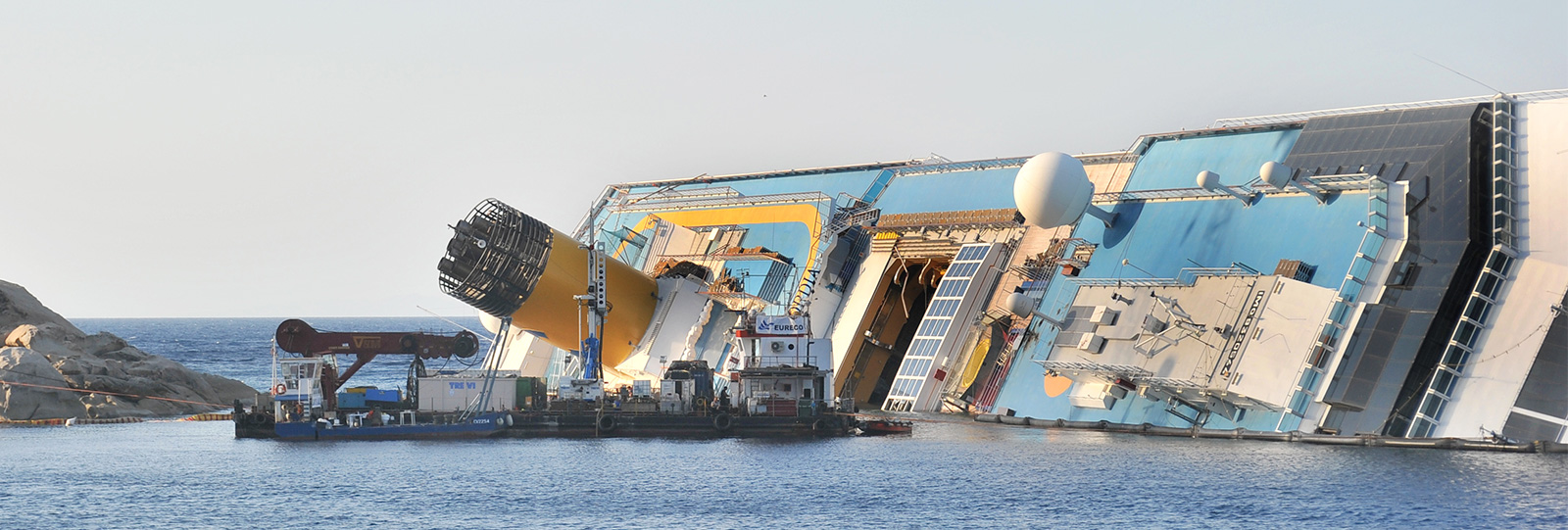COSTA CONCORDIA WRECK PARBUCKLING AND REMOVAL
Trevi Group has performed important preliminary work, essential for the project to salvage the Costa Concordia, wrecked just meters off the shore of the Tuscan Giglio Island since January 13, 2012. The Costa Concordia wreck is now upright and resting safely on the specially built artificial sea bed, at a depth of approximately 30 meters. The parbuckling operation was successfully completed, after 19 working hours, on September 17, 2013.
Early stages
Soon after the accident, 2,380 tons of fuel on board was successfully removed in order to prevent a major threat to the environment. There was also the complexity in removing the ship (290.2 m length overall, 35.5 m beam and light ship weight of over 45,000 tons) without jeopardizing the marine life of the protected area.
After evaluating several projects, Costa Concordia Management awarded the recovery operation to the U.S. and Italian partnership of Titan-Micoperi, who presented an innovative plan in towing away the stricken ship in one piece. The sheer size of the cruise liner, its position with respect to the shore and the risks related to its removal made the salvage the most complex ever attempted.
However, the project incorporated a series of preparations crucial to following operation, including a seabed investigation to precisely determine its composition and the installation of an anchor system to secure the wreck before the Winter sea-storms approach.
Trevi Group in charge of soil investgation and anchors
Stabilizing the wreck required anchors to be installed between the liner and shore. Metal structures weighting over 30 tons were secured to these anchors, and then connected with large steel cables to tie back the ship and prevent it from sliding deeper. Soil investigations and anchor installation were handed over to Trevi Group, who split the job between two divisions: RCT, for the geological survey and Trevi, the company of the Group specialized in ground engineering, for the anchors. The operation is unprecedented from a geotechnical standpoint due to the high specialization and experience required.
Soilmec machines in action
For soil investigations, RCT used an SM-20 drilling rig, whereas for anchors Trevi used an SM-21 drilling rig. Both machines were supplied by Soilmec, company of the Trevi Group specializing in the design and production of machinery for special foundation work.
Trevi has been active for over 50 years in the field of ground engineering in every corner of the world, consistently standing out for completing projects of extreme complexity. From the stabilization of the Tower of Pisa and the bell tower of Saint Mark's Square in Venice, to the stabilization of LPV-111 Levee in New Orleans after Hurricane Katrina and several other dams in the U.S., the consolidation works for the niches of Bamiyan Buddha’s in Afghanistan, to the foundation works in New York City for Ground Zero and the completion of dozens of marine projects in challenging conditions in Europe and Africa. Trevi can always count on invaluable expertise, special equipment and, above all, on human capital, allowing it to hold prominence in its field on a global scale.
To learn more on Costa Concordia parbuckling operations, please visit www.theparbucklingproject.com




